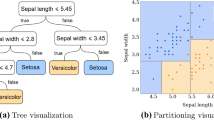Abstract
Practical machine learning algorithms are known to degrade in performance (prediction accuracy) when faced with many features (sometimes attribute is used instead of feature) that are not necessary for rule discovery. To cope with this problem, many methods for selecting a subset of features have been proposed. Among such methods, the filter approach that selects a feature subset using a preprocessing step, and the wrapper approach that selects an optimal feature subset from the space of possible subsets of features using the induction algorithm itself as a part of the evaluation function, are two typical ones. Although the filter approach is a faster one, it has some blindness and the performance of induction is not considered. On the other hand, the optimal feature subsets can be obtained by using the wrapper approach, but it is not easy to use because of the complexity of time and space. In this paper, we propose an algorithm which is using rough set theory with greedy heuristics for feature selection. Selecting features is similar to the filter approach, but the evaluation criterion is related to the performance of induction. That is, we select the features that do not damage the performance of induction.
Similar content being viewed by others
References
Aho, A.V., Hopcroft, J.E., and Ullman, J.D. (1983). Data Structures and Algorithms. Reading, MA: Addison-Wesley Publishing Company.
Boussouf, M. (1998). A Hybrid Approach to Feature Selection. In Zytkow, J. and Quafafou, M. (Eds.), Principles of Data Mining and Knowledge Discovery (pp. 231-238). LNAI 1510, Berlin: Springer-Verlag.
Dong, J.Z., Zhong, N., and Ohsuga, S. (1999). Probabilistic Rough Induction: The GDT-RS Methodology and Algorithms. In Z.W. Ras and A. Skowron (Eds.), Foundations of Intelligent Systems (pp. 621-629). LNAI 1609, Berlin: Springer-Verlag.
Fayyad, U.M., Piatetsky-Shapiro, G., and Smyth, P. (1996). From Data Mining to Knowledge Discovery: An Overview. In Advances in Knowledge Discovery and Data Mining. Cambridge, MA: (pp. 1-36). MIT Press.
Liu H. and Motoda, H. (1998). Feature Selection. Boston, MA: Kluwer Academic Publishers.
Kohavi, R. (1994). Useful Feature Subsets and Rough Set Reducts. In Proc. Third International Workshop on Rough Set and Soft Computing (pp. 310-317).
Kohavi, R. (1994). Feature Subset Selection as Search with Probabilistic Estimates. In Proc. AAAI Fall Symposium on Relevance (pp. 109-113).
Kohavi, R. (1994). Feature Subset Selection Using the Wrapper Method: Overfitting and Dynamic Search Space Topology. In Proc. AAAI Fall Symposium on Relevance (pp. 109-113).
Pawlak, Z. (1982). Rough Sets, International Journal of Computer and Information Sciences, 11, 341-356.
Pawlak, Z. (1991). Rough Sets, Theoretical Aspects of Reasoning about Data. Boston, MA: Kluwer Academic Publishers.
Polkowski, L. and Skowron, A. (Eds.) (1998). Rough Sets in Knowledge Discovery, Vol.1, 2. Heidelberg: Physica-Verlag.
Skowron, A. and Rauszer, C. (1992). The Discernibility Matrics and Functions in Information Systems. In R. Slowinski (Ed.), Intelligent Decision Support (pp. 331-362). Boston, MA: Kluwer Academic Publishers.
Skowron, A. and Polkowski, L. (1997). A Synthesis of Decision Systems from Data Tables. In T.Y. Lin and N. Cercone (Eds.), Rough Sets and Data Mining (pp. 259-299). Boston, MA: Kluwer Academic Publishers.
Yao, Y.Y., Wong, S.K.M., and Butz, C.J. (1999). On Information-Theoretic Measures of Attribute Importance. In Zhong, N. and Zhou, L (Eds.), Methodologies for Knowledge Discovery and Data Mining (pp. 231-238). LNAI 1574, Berlin: Springer-Verlag.
Zhong, N. Dong, J. Z., and Ohsuga, S. (1998). Data Mining: A Probabilistic Rough Set Approach. In Skowron, A. and Polkowski, L. (Eds.), Rough Sets in Knowledge Discovery, Vol. 2, Heidelberg: (pp. 231-238). Physica-Verlag.
Zhong, N., Skowron, A., and Ohsuga, S. (Eds.) (1999). New Directions in Rough Sets, Data Mining, and Granular-Soft Computing. LNAI 1711, Berlin: Springer-Verlag.
Zhong, N. and Zhou, L. (Eds.) (1999). Methodologies for Knowledge Discovery and Data Mining. LNAI 1574, Berlin: Springer-Verlag.
Zupan, B., Bohanec, M., Demsar, J., and Bratko, I. (1998). Feature Transformation by Function Decomposition, IEEE Intelligent Systems, 13(2), 38-43.
Author information
Authors and Affiliations
Rights and permissions
About this article
Cite this article
Zhong, N., Dong, J. & Ohsuga, S. Using Rough Sets with Heuristics for Feature Selection. Journal of Intelligent Information Systems 16, 199–214 (2001). https://doi.org/10.1023/A:1011219601502
Issue Date:
DOI: https://doi.org/10.1023/A:1011219601502




